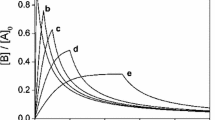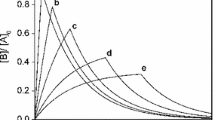Abstract
This paper introduces and discusses a mechanical method to derive rate matrices of 1st order chemical kinetic processes. The methodology is extended, with minor changes, to higher-order kinetics and in far from equilibrium reactions in flow systems.
Similar content being viewed by others
References
L. Papula: Mathematik für Chemiker. F. Enke-Verlag, Stuttgart 1975.
J. W. Moore, R. G. Pearson: Kinetics and Mechanism. Wiley, New York 1981.
H. Eyring, S. H. Lin, S. M. Lin: Basic Chemical Kinetics. Wiley, New York 1980.
M. N. Berberan-Santos, J. M. G. Martinho: J. Chem. Ed.,67, 375 (1990).
L. Pogliani, M. Terenzi: J. Chem. Ed.,69, 278 (1992).
Proc. International Conference on Dynamics of Exotic Phenomena in Chemistry, Hajdúszoboszló, Hungary, August 22–25, 1989. React. Kinet. Catal. Lett.,42, No. 2, (1990).
Author information
Authors and Affiliations
Rights and permissions
About this article
Cite this article
Pogliani, L. How to construct first-order kinetic matrices and higher-order kinetic matrices. React Kinet Catal Lett 49, 345–351 (1993). https://doi.org/10.1007/BF02067702
Received:
Accepted:
Issue Date:
DOI: https://doi.org/10.1007/BF02067702




